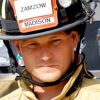Spend a little time with some first responder fitness enthusiasts and you might just hear something along the lines of, “How much do you bench, bro?” Men and women often find it motivating to set and exceed bench press goals and other measures that isolate specific muscle groups. But for firefighters and EMS personnel, breaking your workout into body part segments should be secondary to functional training.
What does functional training mean? The term is loosely thrown around podcasts and YouTube videos and in group exercise classes. One of the best definitions I found is from Mayo Clinic, which defines functional training as “Training the body for the activities performed in daily life.”
In the context of the fire/rescue scene, that means:
- Crawling
- Pulling
- Hoisting
- Carrying
- Dragging
- Climbing
- Slamming
- Balancing
- Twisting
Notice that all these motions require good stabilization and core strength and none of them isolate muscle groups—except maybe when the chief points at the fire!
Going back to the original question of how much do you bench—is the bench press a functional exercise? It is debatable. I am not saying you should not do it; I’m asking for you to start thinking about your exercise and workouts in a manner of function. Are your workouts helping you perform and move better on the fireground?
Here are three ways to improve performance with functional training for firefighters and EMS personnel:
- Incorporate mobility exercises into every workout (and every day)
- Incorporate core exercises into every workout (and every day). Movements like spidermans and planks are a great way to start for these first two.
- Use full-body strength training. Perform exercises that incorporate upper- and lower-body muscle groups like the alternate arm chest press, one-arm rows, and squat-to-overhead press.
Think about the exercises you do in your workouts and strive to get more functional.
Questions? Contact me at zamzowfitness@gmail.com or visit Fire Rescue Fitness.




